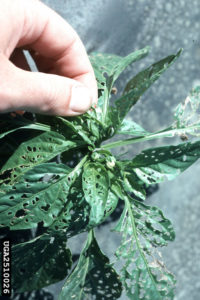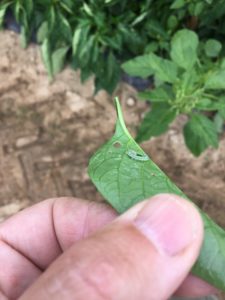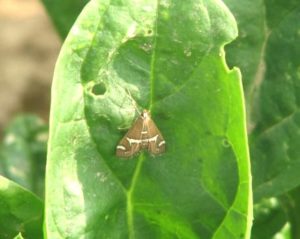Sweet Corn
Fall armyworm (FAW) larval infestations remain at low levels in the few remaining sweet corn plantings not yet silking. At this point in the season, FAW shouldn’t become a widespread economic problem. However, growers should be alert to the possibility of infestations on the last of their late plantings. Injury from newly hatched larvae shows up as “window panes” or areas where leaf tissue has been eaten down the the lower epidermis. This injury leads down into the whorl. As larvae gain size, they begin to consume leaf tissue in its’ entirety, creating ragged holes and lots of droppings. FAW can be tough to manage because it is resistant to synthetic pyrethroid insecticides (IRAC 3A) and because larvae are often covered by their own droppings, making contact with the insecticide more difficult. Treat when 12% or more plants exhibit FAW injury alone, or in combination with ECB injury.
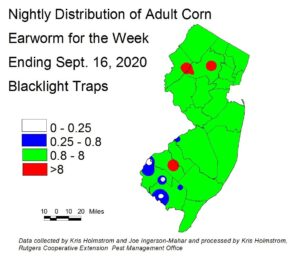 Corn earworm (CEW) moth captures continued a gradual decline over this past week due to several nights with low temperatures. The decline is less noticeable in the northern counties, where CEW blacklight catches had been quite high prior to the onset of cooler weather. Therefore the weekly averages there are higher. Overall, these catches are representative of lower adult activity, and growers should consider this pest to still be at moderately high population levels in the state. The current population poses a significant risk to silking corn. The reduction in CEW catch was not enough to substantially change this weeks map from last week (see map at left). Green areas on this map representing a 3-day spray schedule. For further information on CEW activity, see pheromone trap information below.
Corn earworm (CEW) moth captures continued a gradual decline over this past week due to several nights with low temperatures. The decline is less noticeable in the northern counties, where CEW blacklight catches had been quite high prior to the onset of cooler weather. Therefore the weekly averages there are higher. Overall, these catches are representative of lower adult activity, and growers should consider this pest to still be at moderately high population levels in the state. The current population poses a significant risk to silking corn. The reduction in CEW catch was not enough to substantially change this weeks map from last week (see map at left). Green areas on this map representing a 3-day spray schedule. For further information on CEW activity, see pheromone trap information below.
The highest nightly trap catches of CEW in black light traps for the week ending 9/16/20 are as follows:
| Hackettstown 19 | Morristown 8 | Port Colden 6 |
| Long Valley 16 | Allamuchy 7 | Princeton 6 |
| Denville 13 | Sereantsville 7 | Blairstown 5 |
| Chester 9 | Downer 6 | Hillsborough 5 |
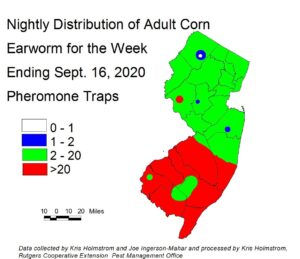 A similar temperature-based reduction in CEW pheromone catch occurred this past week (see CEW pheromone map at left). The blacklight network is indicating a 3-day silk spray schedule in the northern counties, while the pheromone network is at 4-day. Under these conditions, it is best to adhere to the more conservative schedule in any given area. Red areas indicate a 3 day schedule on the pheromone map, which is in agreement with the blacklight map for southern NJ. The number of pheromone traps deployed is much lower, resulting in much broader color bands on the map. The current population is a serious economic threat. It is important to use effective materials to manage this pest on silking corn. Insecticides in the IRAC 28 class (Coragen, Besiege, Exirel) and IRAC 5 (Radiant, Blackhawk, Entrust (OMRI approved)) remain among the most useful insecticides against CEW.
A similar temperature-based reduction in CEW pheromone catch occurred this past week (see CEW pheromone map at left). The blacklight network is indicating a 3-day silk spray schedule in the northern counties, while the pheromone network is at 4-day. Under these conditions, it is best to adhere to the more conservative schedule in any given area. Red areas indicate a 3 day schedule on the pheromone map, which is in agreement with the blacklight map for southern NJ. The number of pheromone traps deployed is much lower, resulting in much broader color bands on the map. The current population is a serious economic threat. It is important to use effective materials to manage this pest on silking corn. Insecticides in the IRAC 28 class (Coragen, Besiege, Exirel) and IRAC 5 (Radiant, Blackhawk, Entrust (OMRI approved)) remain among the most useful insecticides against CEW.
The highest nightly trap catches of CEW in pheromone traps for the week ending 9/16/20 are as follows:
| Green Creek 63 | Pedricktown 36 | Berlin 12 |
| Eldora 55 | Snyder Farm (Hunterdon) 23 | Chester 10 |
| Springdale 46 | Folsom 17 | Crosswicks 10 |
| Monroeville 44 | Woodstown 17 | Dayton 7 |
Silking Spray Schedules*:
South – 3 days
Central – 3 days
North – 3 days
*These recommendations are based on regional catches. Adhere to tighter spray schedules if indicated by local trap catches. Synthetic pyrethroids alone should NOT be used for corn earworm (CEW) protection on silking corn, or for fall armyworm (FAW) management at any stage. Control with these materials is very inconsistent.
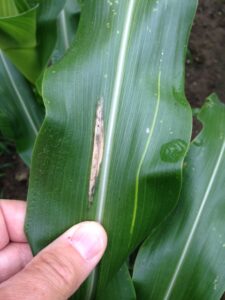 As night temperatures drop, and dew periods lengthen, northern corn leaf blight (NCLB) will increase in frequency and severity. This fungal disease causes elongated gray streaks on leaves. The lower leaf surface will develop greenish-gray sporulation. If cooler, moist conditions persist, this disease can invade enough tissue to limit ear size. Lesions can also develop on husks, resulting in an unsightly ear. If these lesions are discovered in the pre-tassel stage or earlier, fungicide applications may be warranted. Realistic control of this disease requires a combination of protectant (mancozeb, chlorothalonil) and locally systemic fungicides in FRAC groups 3,7 and 11. For a complete list of materials, see the Sweet Corn Section of the Commercial Vegetable Production Recommendations.
As night temperatures drop, and dew periods lengthen, northern corn leaf blight (NCLB) will increase in frequency and severity. This fungal disease causes elongated gray streaks on leaves. The lower leaf surface will develop greenish-gray sporulation. If cooler, moist conditions persist, this disease can invade enough tissue to limit ear size. Lesions can also develop on husks, resulting in an unsightly ear. If these lesions are discovered in the pre-tassel stage or earlier, fungicide applications may be warranted. Realistic control of this disease requires a combination of protectant (mancozeb, chlorothalonil) and locally systemic fungicides in FRAC groups 3,7 and 11. For a complete list of materials, see the Sweet Corn Section of the Commercial Vegetable Production Recommendations.
Pepper weevil (PW)
With the growing season beginning to wind down, several fields of peppers are being chopped up. The concern about the weevils is decreasing now. Only the farmers that attempt to continue to harvest into the fall will need to keep an eye out for them. On at least at two farms, we have seen the typical pattern of the elimination of smaller fruit and severe reduction of new flower buds.
Look for an announcement for a meeting this winter regarding the management of pepper weevils. Grower input is necessary to determine how to proceed with research and the best strategies for dealing with this pest.
As for control materials, Florida insecticide trials indicate that Actara, Vydate, Harvanta, and Torac provide the best results, however, there is a broad range of materials including pyrethroids and neonics that can kill the adults. The hope is to eliminate the weevil population before it becomes established in the field. A combination of spraying, trapping, and removal of aborted fruit would help to manage this pest.
Pheromone trap catches of beet armyworm (BAW) have increased in southern NJ traps. Scattered individual larvae continue to appear in some northern and central NJ cole crop fields. Growers should be alert to the potential for infestation from this pest. Look for clusters of pepper plants with lace-like damage to foliage near growing points (see photo at upper left). The green caterpillars will be found among these damaged leaves (see photo at lower left). After consuming foliage, BAW can begin to damage fruit directly. It is also important to note that BAW, like FAW, is resistant to synthetic pyrethroid insecticides. For this reason, materials in the IRAC 5 and 28 classes should be used in response to an infestation.
The highest nightly trap catches of BAW in pheromone traps for the week ending 9/16/20 are as follows:
| Folsom-1 143 | Folsom-2 36 |
| East Vineland 49 | Cedarville 11 |
| Woodstown 37 |
Pumpkins and Winter Squash
The cucurbit downy mildew (CDM) sentinel plot at Snyder Farm in Hunterdon County, consisting of pumpkin, watermelon, cantaloupe, butternut, acorn, cucumber and kabocha squash is used to indicate the presence of cucurbit downy mildew in the region, and what crops are affected. As of 9/16/20, there was no CDM detected on any of the other cucurbit types, and all reported infections in our region have been on cucumber, with one (now old) from Long Island reported on muskmelon. For regional information on this important disease, see the Cucurbit Downy Mildew Forecast webpage: http://cdm.ipmpipe.org/. As of this Tuesday (9/15/20), New Jersey was rated at minimal risk for new infections by CDM from current regional sources. It looks likely that we will escape 2020 without a CDM infection on pumpkins or winter squash in NJ.
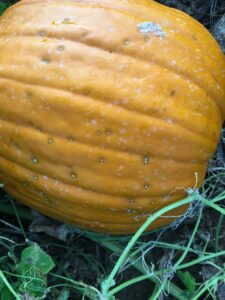 As fruit mature, and vines begin to decline in some fields, growers may notice that white pits have formed on some fruit (see photo at left). These may also be sunken on the fruit surface, and can have a gum-like ooze extruding from the lesions. This is bacterial leaf spot, as it infects fruit. Despite including copper in regular powdery mildew sprays, bacterial leaf spot infections on fruit are fairly common this year. These fruit may not hold well in storage, and growers should consider not adding them to bins in case they break down. Fungicides and suggested rotations are found in the Pumpkin and Winter Squash section of the Commercial Vegetable Production Recommendations.
As fruit mature, and vines begin to decline in some fields, growers may notice that white pits have formed on some fruit (see photo at left). These may also be sunken on the fruit surface, and can have a gum-like ooze extruding from the lesions. This is bacterial leaf spot, as it infects fruit. Despite including copper in regular powdery mildew sprays, bacterial leaf spot infections on fruit are fairly common this year. These fruit may not hold well in storage, and growers should consider not adding them to bins in case they break down. Fungicides and suggested rotations are found in the Pumpkin and Winter Squash section of the Commercial Vegetable Production Recommendations.
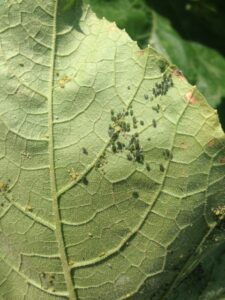 Melon aphid (see photo at left) populations are more frequent in pumpkin and winter squash fields. This aphid builds to heavy populations
Melon aphid (see photo at left) populations are more frequent in pumpkin and winter squash fields. This aphid builds to heavy populations 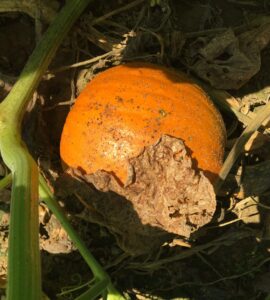 that result in the deposition of sticky droppings on the surface of fruit (see photo at right). If melon aphids appear in more than one sample site in a 10 site sample, consider treating to minimize the appearance of droppings. Insecticides effective at managing this pest are found in the Pumpkin and Winter Squash section of the Commercial Vegetable Production Recommendations.
that result in the deposition of sticky droppings on the surface of fruit (see photo at right). If melon aphids appear in more than one sample site in a 10 site sample, consider treating to minimize the appearance of droppings. Insecticides effective at managing this pest are found in the Pumpkin and Winter Squash section of the Commercial Vegetable Production Recommendations.
Cole Crops
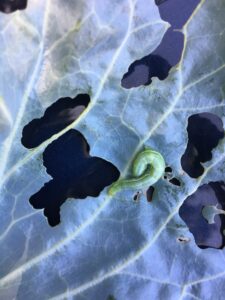 Fall plantings of cole crops are well underway at this time, and are frequently infested by imported cabbageworm (ICW) and diamondback moth (DBM) larvae. At this time, cabbage looper (CL-photo at left) and cross striped cabbage worm (CSCW-photo at right) are also causing
Fall plantings of cole crops are well underway at this time, and are frequently infested by imported cabbageworm (ICW) and diamondback moth (DBM) larvae. At this time, cabbage looper (CL-photo at left) and cross striped cabbage worm (CSCW-photo at right) are also causing injury to these crops.
injury to these crops.
Check 5 consecutive plants each in 10 random locations throughout the planting. Consider treating if caterpillars are found on 10% or more plants that are in the 0-9 true leaf stage. From 9-leaf to the early head stage (in broccoli, cauliflower, and cabbage) infestations up to 20% may be tolerated. Once heads begin to form, a 5% threshold should be observed to protect the marketable portion of the plant. For leafy greens such as collards and kale, 10% plants infested is the threshold throughout.
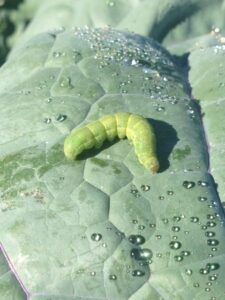 Some populations of DBM are resistant to carbamate and synthetic pyrethroid insecticides. The lack of DBM control with these insecticides has been noted in NJ previously. It is important to distinguish between common cole crop pests for this reason. DBM larvae grow to a length of approximately 0.5”, and taper toward both ends (see photo at right). These caterpillars thrash violently when disturbed. Newer chemistries that specifically target caterpillar pests are effective against DBM as well as all other caterpillar pests of cole crops, including beet armyworm (BAW-see photo at right), another species with exhibiting pyrethroid resistance. These materials include (active ingredient – trade name (IRAC* code)):
Some populations of DBM are resistant to carbamate and synthetic pyrethroid insecticides. The lack of DBM control with these insecticides has been noted in NJ previously. It is important to distinguish between common cole crop pests for this reason. DBM larvae grow to a length of approximately 0.5”, and taper toward both ends (see photo at right). These caterpillars thrash violently when disturbed. Newer chemistries that specifically target caterpillar pests are effective against DBM as well as all other caterpillar pests of cole crops, including beet armyworm (BAW-see photo at right), another species with exhibiting pyrethroid resistance. These materials include (active ingredient – trade name (IRAC* code)):
Spinosad/Spinetoram – Entrust(OMRI)/ Radiant (5)
Chlorantraniliprole – Coragen (28)
Cyantraniliprole – Exirel (28)
Spinach, beets and chard
Hawaiian beet webworm (HBWW) moths have been detected on several central NJ farms. Thus far, these moths have been seen in weedy areas of non-host crops. Though their occurrence is not widespread at this time, the moths are quite numerous where they have been found. Farmers with spinach, beets, and chard should check their fields for the presence of webbing and feeding injury. These are small migratory moths usually occurring in mid-to-late summer. Their favored host is the pigweed, Amaranthus sp., but they are capable of causing defoliation and contamination to crops. Since they are migratory and have a short life cycle they can rapidly appear and cause extensive damage to crops unnoticed.
